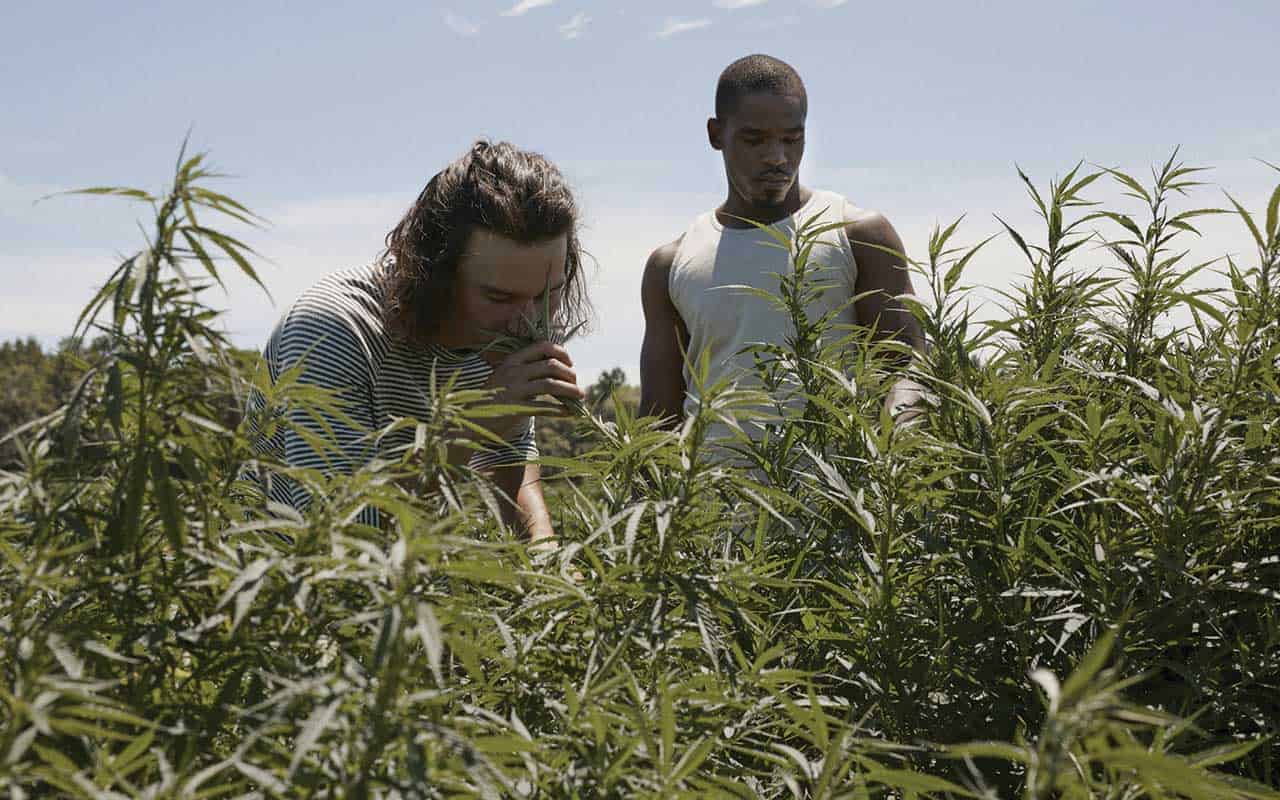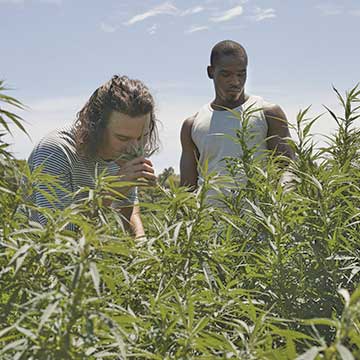This Month’s Featured Article

Farming for the Future
 My introduction to Hudson Hemp was at a pop-up market in the round barn at Churchtown Dairy outside of Hudson, NY. It was late fall of 2018. The round barn is a marvel in and of itself, an already magical space, and having local vendors in it with a variety of handmade goodies and wares made it even more so. It’s the perfect space in which to learn about what your neighbors are making and growing. On this beautiful late fall afternoon, in the heart of harvest season, I expected vegetables and honey and eggs, cheese and meat and bread, soaps and candles and yarns, beer and wine and spirits.
My introduction to Hudson Hemp was at a pop-up market in the round barn at Churchtown Dairy outside of Hudson, NY. It was late fall of 2018. The round barn is a marvel in and of itself, an already magical space, and having local vendors in it with a variety of handmade goodies and wares made it even more so. It’s the perfect space in which to learn about what your neighbors are making and growing. On this beautiful late fall afternoon, in the heart of harvest season, I expected vegetables and honey and eggs, cheese and meat and bread, soaps and candles and yarns, beer and wine and spirits.
Cannabis comes to Hudson
What I didn’t expect was the unmistakable odor of marijuana. When I caught it, my first thought was that some visitors to the market must have been smoking before coming in. But no, the scent wasn’t something lingering on someone’s clothes or hair, it was from cannabis plants that were part of the display for Hudson Hemp, which was there with its CBD products. Big, bushy cannabis plants were in and around their booth, giving off a strong scent that gave me – a child of the 70s – an illicit thrill. Cannabis = marijuana = drugs = illegal. How were these plants allowed to be here?
I took a closer look. Contrary to anything untoward or suspicious, the immediate impression I got from the Hudson Hemp folks was of calm and clean and professional. There were no batik-patterned throws or tie-dyed T-shirts. The presentation was elegant. Their CBD-based product line is named Treaty, and is targeted to help with states of “calm,” “focus,” “recover,” and “balance.” It was clearly not just me whose curiosity was piqued that afternoon. The lines were always long at the Hudson Hemp table. Hemp. In Hudson. I wanted to learn more.
The area has the Dobson family to thank for bringing the riches of hemp to Hudson. Siblings Benjamin, Melany, and Freya grew up on a farm in the Berkshires, and its lessons sustained and shaped them all. Ben was managing Old Mud Creek Farm (site of Hudson Hemp) and Stone House Grain, which together comprise 2700 acres. Ben had applied for a license to grow hemp, which he knew could sequester carbon. His sisters were both in the cannabis business in Northern California, which had its fair share of, according to Freya, “outlaws, back to landers, hippies, and criminals.” When Ben reached out to them in 2017 to help create a product line for his hemp harvest, they knew it was time to return East.
Both on the founding team, Melany is now the VP of brand development, and Freya is head of partnerships. The sisters work side-by-side to fulfill the company’s – and the products – missions and visions, with Ben as the overseer. Treaty was named for its combination of the words “tree” and “tea” – trees are life-giving plants and tea is the center of a special ceremony. “Hemp is a hero crop, for us,” Freya said, “because it has a unique way of connecting people with plants. Its ties to cannabis elicit strong feelings, and its many other positive benefits have brought people around to ‘reclaim’ it in a sense. It’s so versatile; we’re just getting started with it.”
Yes, it’s a crop, and yes, it is multi-faceted. But what is hemp? How is it different from marijuana? I soon realized I had only misconceptions about what it is, what it’s for, and how it’s grown.
Understanding Hemp and CBD vs. THC
Hemp is indeed a cannabis plant. Cannabis sativa plants contain uniquely structured chemicals called cannabinoids. There are over 70 different cannabinoids, but the two best-known for their medical benefits are THC (tetrahydrocannabinol) and CBD (cannabidiol). THC is the one that can elicit the psychotropic “high” associated with marijuana. CBD, on the other hand, is a non-psychoactive cannabinoid. Both have distinct documented medical benefits, but for those who don’t want to experience the psychotropic effects of THC, CBD is a viable alternative. CBD is derived from hemp, which is cannabis that has been bred to have very low amounts of THC cannabinoids. CBD is not listed as a Controlled Substance in the US so long as it is not extracted from marijuana; rather, it is considered a dietary supplement, legal to buy and sell in all 50 states.
Hemp farmers have to work hard to remind people of the distinction between their plants and cannabis sativa grown for marijuana. And they grow them for more than just their CBD-yielding compounds. Throughout history, hemp has been used as a source of fiber, fuel, and even food, in addition to health and medicine.
More than a plant
Hudson Hemp is all about bringing this plant’s array of benefits to a wider audience. I found this on their Facebook page: “Organically grown hemp is the future in creating regional economies of scale. As advocates for the plant as a food, fuel, fiber, and medicine, we envision a future where plant medicine restores the earth, the people, and their industries.”
It sounds revolutionary yet elemental at the same time – a plant with such potential for people and for the earth itself. It’s exciting. And while the benefits of CBD-based products are the “sexy” end product, just as wine is with grapevines, you can’t get there without understanding where and how the plant is grown. And to do that, you have to talk to The Farmer. At Hudson Hemp, that’s Brandon Curtin.
Brandon’s official title at Hudson Hemp is cultivation manager, but just a few minutes into a conversation with him about the pleasures and perils of the hemp crop, and you learn that really he’s the Hemp Headmaster. Brandon’s vision extends from concept through cultivation, with a particular passion for the regenerative model of farming in which Hudson Hemp’s crop is the star.
“Regenerative farming is about more than your yield at the end of a growing season,” he said when I caught up with him recently. “If you want healthy plants that are of the highest quality, soil is the key to it all. That’s what supports the crop year after year, so if you can get more organic matter into the soil than you’re taking out, you’re rejuvenating it.”
Regeneration is forever
For him, regenerative farming is about even more than the soil and the plants. “You hear a lot about organic and sustainable agriculture,” Brandon said. “You can farm organically, and with sustainability as your guide, but with either or both you’re still losing organic matter year after year. With regenerative farming, the goal is to reduce the impact on the soil overall, to put even more organic matter back. Regeneration also has to do with people,” he said. “There are social aspects, like fair wages and working together.”
Brandon took to farming at an early age. He grew up in Great Barrington, MA, and his grandfather was a farmer. Working in a greenhouse for a class in high school was the catalyst to his career. He went on to attend the Stockbridge School of Agriculture at the University of Massachusetts, Amherst, graduating with a degree in Sustainable Food and Farming. “Soil science and vegetable production were my primary interests,” he said, and these led him to work at a cannabis farm in California. That experience made him even more qualified to “come home” to the upper Hudson Valley/Berkshires area, where his friend Benjamin Banks-Dobson had started Hudson Hemp.
“Ben started the farm as a carbon research center,” Brandon said, “so the interest in the symbiosis between land, plant, and people was already a fundamental part of what was happening.”
On the farm in Hudson – and beyond
Brandon has been at Hudson Hemp for four years now and oversees 30 acres of hemp plants. Thirty acres is a sizable farm. “We used to use plastic mulch as a way to up production and cut labor,” he said, “so I knew that had to change. We’re now composting the waste material back into the soil – I even make a compost ‘tea’ that creates an aeration in the compost that makes it more effective,” he adds. “We know our soil is doing well because there’s a lush population of bacteria and fungi. We have lots of mushrooms!”
I ask Brandon his thoughts about biodynamic farming. “It’s an inspiration, for sure,” he says, “but I’m more of a fan of Korean Natural Farming, established by Dr. Cho in Korea. It’s practiced in the US in a way that I like by Chris Trump, who converted his family’s 800-acre macadamia farm in Hawaii with KNF with great success.”
Brandon shares that he’s also influenced by the book The One-Straw Revolution: An Introduction to Natural Farming, by Masanobu Fukuoka (NYRB Classics, 2009). “A preventive rather than curative approach is best,” he said. “A farmer’s greatest cost is dealing with a toxic component. When the soil is good and the plants are healthy and the ecosystem is in balance, then the crop yields and quality are up.”
Freya agreed, noting that a directive for Hudson Hemp going forward is to bring even more focus to the quality of its flowers. With less THC and more CBD focused in that part of the plant, more and more people want to smoke the flowers of hemp as they would marijuana. Different extraction methods also yield different concentrations with different characteristics. “There’s also the other parts of the plant,” Freya said. “We’re researching how the roots were used by the Chinese for medicinal purposes. The fiber and fuel components are interesting – though that requires separating male and female plants so they don’t cross-pollinate,” she added.
It’s fortunate for our area that the male and female Dobsons came together to create all that is Hudson Hemp. It’s important and worthwhile to look at what is grown around us, to pay attention to what we bring into our bodies and our homes. What the potential is for farming that actually gives back to the earth, its animals and its people. •
Learn more at www.hudsonhemp.com, where you can shop for Treaty, hemp oil extracts, and a kava-ginger hemp body salve. Hudson Hemp also offers farm tours in the summer that celebrate life on its farm and those of sister farms in the area.


